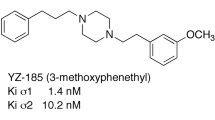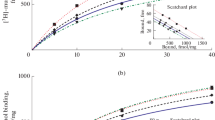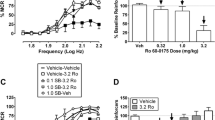Abstract
Several high affinity sigma (σ) ligands, such as DTG, JO-1784, (+)-pentazocine, BD-737 and L-687,384, administered at low doses act as agonists by potentiating N-methyl-d-aspartate (NMDA)-induced activation of pyramidal neurons in the CA3 region of the rat dorsal hippocampus. This potentiation is dose-dependent at doses between 1 and 1000 µg/kg, IV but bell-shaped dose-response curves are obtained. Other σ ligands like haloperidol, BMY-14802, (+)3-PPP and NE-100 administered at low doses act as σ antagonists, since they do not modify the NMDA response but suppress the potentiation of the NMDA response induced by σ agonists. Because high doses of the σ agonists do not potentiate the NMDA response, the present experiments were undertaken to assess if, at high doses, these σ ligands could also act as σ antagonists and suppress the potentiation induced by low doses of a agonists. High doses of DTG, JO-1784, BD-737, and L-687,384, administered acutely, had an effect similar to that of low doses of haloperidol, by suppressing and preventing the potentiation induced by low doses of DTG, JO-1784, BD-737, L-687,384 and (+)-pentazocine. High doses of (+)-pentazocine suppressed the effect of a low dose of (+)-pentazocine but did not affect the potentiation induced by a low dose of the other σ agonists. The potentiation induced by a low dose of a σ 1 agonist was not further increased by the subsequent administration of another low dose of a σ 1 agonist. All together, these results strongly suggest that more than two subtypes of σ receptors exist in the CNS.
Similar content being viewed by others
References
Bergeron R, Debonnel G, De Montigny C (1993) Modification of the N-methyl-d-aspartate response by antidepressant sigma receptor ligands. Eur J Pharmacol 240:319–323
Bergeron R, De Montigny C, Debonnel G (1995) Biphasic effects of sigma ligands on the neuronal response to N-methyl-d-aspar-tate. Naunyn-Schmiedeberg’s Arch Pharmacol 351:252–260
Bergeron R, De Montigny C, Debonnel G (1996) Short-term and long-term treatments with sigma ligands modify the N-methyl-d-aspartate response in the CA3 region of the rat dorsal hippocampus. Br J Pharmacol (in press)
Church J, Fletcher EJ (1995) Blockade by sigma site ligands of high voltage-activated Ca2+ channels in rat and mouse cultured hippocampal pyramidal neurones. Br J Pharmacol 675:110–120
Church J, Lodge D (1990) Failure of sigma-receptor ligands to reduce the excitatory actions of N-methyl-d-aspartate on rat spinal neurons in vivo. J Pharm Pharmacol 42:56–57
Contreras PC, Ragan DM, Bremer ME, Lanthom TH, Gray NM, Iyengar S, Jacobson AE, Rice KC, de Costa BR (1991a) Neuroprotective activity in the gerbil. Brain Res 546:79
Contreras PC, Ragan DM, Bremer ME, Lanthom TH, Gray NM, Iyengar S, Jacobson AE, Rice KC, de Costa BR (1991b) Evaluation of U-50, 488H analogs for neuroprotective activity in the gerbil. Brain Res 546:79–82
Contreras PC, Gray NM, Ragan DM, Lanthom TH (1992) BMY-14802 protects against ischemia-induced neuronal damage in the gerbil. Life Sci 51:1145–1149
Debonnel G, De Montigny C (1996) Modulation of NMDA and dopaminergic neurotransmission by sigma ligands: possible implication for the treatment of psychiatric disorders. Life Sci 58:712–738
Debonnel G, Bergeron R, Monnet FP, De Montigny C (1996) Differential effects of sigma ligands on the NMDA response in CA1 and CA3 regions of dorsal hippocampus: effects of mossy fiber lesioning. Neuroscience 71:977–987
Fletcher EJ, Church J, Abdel-Hamid K, MacDonald JF (1993) Selective reduction of N-methyl-d-aspartate-evoked responses by l,3-di(2-tolyl)guanidine in mouse and rat cultured hip-pocampal pyramidal neurones. Br J Pharmacol 109:1196–1205
Fletcher EJ, Church J, Abdel-Hamid K, MacDonald JF (1995) Blockade by sigma site ligands of N-methyl-d-aspartate-evoked responses in rat and mouse cultured hippocampal pyramidal neurones Br J Pharmacol 116:2801–2810
Foster AC, Fagg GE (1984) Acidic amino acid binding sites in mammalian neuronal. Their characteristics and relationship to synaptic receptors. Brain Res Rev 7:103–164
Graybiel AM, Besson MJ, Weber E (1989) Neuroleptic-sensitive binding sites in the nigrostriatal system. Evidence for differential distribution of sigma sites in the subtantia nigra, pars compacta of the cat. J Neurosci 9:326–338
Haigler HJ, Aghajanian GK (1974) Lysergic acid diethylamide and serotonin; a comparison of effects on serotonergic neurons receiving a serotonergic input. J Pharmacol Exp Ther 168: 688–699
Kandel ER, Spencer WA (1961) Electrophysiology of hippocampal neurons after potentials and repetitive firing. J Neurophysiol 24:243–259
Lockhart BP, Soulard P, Bonicourt C, Privat A, Junien JL (1995) Distinct neuroprotective profile for sigma ligands against N- methyl-d-aspartate and hypoxia-mediated neurotoxicity in neuronal culture toxicity studies. Brain Res 675:110–120
Martin WR, Eades CG, Thompson JA, Huppler RE, Gilbert PE (1976) The effects of morphine and nalorphine-like drugs in the nondependent and morphine-dependent chronic spinal dog. J Pharmacol Exp Ther 197:517–532
Mclarnon J, Sawyer D, Church J (1994) The actions of L-687, 384, a σ receptor ligand, on NMDA-induced curents in cultured rat hippocampal pyramidal neurons. Neurosci Lett 174:181–184
McQuiston AR, Colmers WF (1992) Neuropeptide Y does not alter NMDA conductances in CA3 pyramidal neurons: a slice-patch study. Neurosci Lett 138:261–264
Middlemiss DN, Billington D, Chambers M, Hutson PH, Knight A, Russell M, Thorn L, Tricklebank MD, Wong EHF (1991) L-687, 384 is a potent, selective ligand at the central sigma recognition site. Br J Pharmacol 102–153
Monnet FP, Debonnel G, Junien JL, De Montigny C (1990) N-Methyl-d-aspartate-induced neuronal activation is selectively modulated by sigma receptors. Eur J Pharmacol 179:441–445
Monnet FP, Debonnel G, De Montigny C (1992) In vivo electrophysiological evidence for a selective modulation of N-methyl-d-aspartate-induced neuronal activiation in rat CA3 dorsal hippocampus by sigma ligands. J Pharmacol Exp Ther 261:123–130
Monnet FP, Debonnel G, Bergeron R, Gronier B, De Montigny C (1994) The effects of sigma ligands and of neuropeptide Y on N-methyl-d-aspartate-induced neuronal activation of CA3 dorsal hippocampus neurones are differentially affected by pertussin toxin. Br J Pharmacol 112:709–715
Okuyama S, Imagawa Y, Ogawa S, Araki H, Ajima A, Tanaka M, Muramatsu M, Nakazato A, Yamaguchi K, Yoshida M, Otomo S (1993) NE-100, a novel sigma receptor ligand. In vivo tests. LifeSci 53:285–290
O’Neill M, Caldwell M, Earley B, Canney B, O’Halloran A, Kelly J, Leonard BE, Junien JL (1995) The sigma receptor JO-1784 (igmesine hydrochloride) is neuroprotective in the gerbil model of global cerebral ischaemia. Eur J Pharmacol 283:217–225
Quirion R, Bowen WD, Itzhak Y, Junien JL, Musacchio JM, Rothman RB, Su TP, Tarn SW, Taylor DP (1992) A proposal for the classification of sigma binding sites. Trends Pharmacol Sci 13:85–86
Roman FJ, Pascaud X, Martin B, Vauche D, Junien JL (1990) JO-1784, a potent and selective ligand for rat and mouse brain sigma sites. J Pharm Pharmacol 42: 439–440
Steinfels GF, Alberici GP, Tarn SW, Cook L (1988) Biochemical, behavioral and electrophysiologic actions of the selective sigma receptor ligand (+)pentazocine. Neuropsychopharmacology 1:321–327
Su TP (1993) Delineating biochemical and functional properties of sigma receptors: emerging concepts. Crit Rev Neurobiol 7:187–203
Taylor DP, Dekleva J (1987) Potential antipsychotic BMY 14802 selectively binds to sigma sites. Drug Dev Res 11:65–70
Taylor DP, Eison MS, Moon SL, Schlemmer RF Jr, Shukla UA, VanderMaelen CP, Yocca FD, Gallant DJ, Behling SH, Boissard CG et al. (1993) A role for sigma binding in the antipsychotic profile of BMY 14802? NIDA Res Monogr 133:125–157
Walker JM, Hunter WS (1994) Role of sigma receptors in motor and limbic system function. Neuropsychopharmacology 10:837s
Walker JM, Bowen WD, Walker FO, Matsumoto RR, de Costa B, Rice KC (1990) Sigma receptors: biology and function. Pharmacol Rev 42:355–402
Weber E, Sonders M, Quarum M, McLean S, Pou S, Keana JF (1986) l,3-Di(2-[5-3H]tolyl)guanidine: a selective ligand that labels sigma-type receptors for psychotomimetic opiates and antipsychotic drugs. Proc Natl Acad Sci USA 83:8784–8788
Author information
Authors and Affiliations
Rights and permissions
About this article
Cite this article
Bergeron, R., Debonnel, G. Effects of low and high doses of selective sigma ligands: further evidence suggesting the existence of different subtypes of sigma receptors. Psychopharmacology 129, 215–224 (1997). https://doi.org/10.1007/s002130050183
Received:
Accepted:
Issue Date:
DOI: https://doi.org/10.1007/s002130050183




